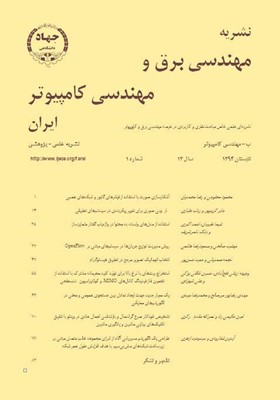استخراج بیتهای با نرخ بالا برای تولید کلید محرمانه مشترک با استفاده از تخمین فاز فیدینگ کانالهای MIMO و کوانتیزاسیون چندسطحی
محورهای موضوعی : مهندسی برق و کامپیوتروجيهه زينلي فتحآبادي 1 , حسين خالقي بيزکي 2 , علی شهزادی 3
1 - دانشگاه صنعتي مالک اشتر
2 - دانشگاه صنعتي مالک اشتر
3 - دانشگاه سمنان
کلید واژه: کلید محرمانه مشترک کانال فیدینگ MIMO تخمین فاز کوانتیزاسیون چندسطحی,
چکیده مقاله :
اخیراً روشهای تولید کلید محرمانه مشترک با استفاده از مشخصات تصادفیبودن دامنه و فاز سیگنال دریافتی و تقارن کانال مشترک در سیستمهای مخابراتی بیسیم، مورد توجه زیادی واقع شده است. پروتکلهای تولید کلید بر اساس تخمین فاز سیگنال دریافتی، به علت توزیع یکنواخت فاز فیدینگ کانال، هم برای محیطهای ساکن و هم سیار مناسب بوده و همچنین دارای نرخ تولید کلید بالاتری نسبت به پروتکلهای تولید کلید بر اساس توان سیگنال دریافتی میباشند. علاوه بر این عموماً کارهای پیشین روی پروتکل تولید کلید روی سیستمهای تکآنتنه (SISO) متمرکز بودهاند که دارای نرخ تولید کلید قابل توجهی نیستند. از این رو در این مقاله برای افزایش تصادفیبودن و نرخ تولید کلید از تخمین فاز سیگنال دریافتی روی سیستمهای چندآنتنه (MIMO) برای تولید کلید محرمانه مشترک استفاده میشود، زیرا سیستمهای MIMO دارای یک توانایی برای عرضه متغیرهای تصادفی بیشتر جهت تولید کلید نسبت به سیستمهای SISO میباشند. نتایج شبیهسازی نشاندهنده این است که نرخ تولید کلید در حالتی که تعداد آنتنهای فرستنده و گیرنده یکسان و برابر با 2 و 3 باشد، به ترتیب 4 و 9 برابر زمانی است که از 1 آنتن فرستنده و گیرنده استفاده شود. همچنین هنگامی که جهت استخراج بیتهای کلید محرمانه از کوانتیزاسیون چندسطحی استفاده شود، نرخ تولید کلید افزایش قابل ملاحظهاي پیدا خواهد کرد.
Much attention has recently been paid to methods of shared secret key generation that exploit the random characteristics of the amplitude and phase of a received signal and common channel symmetry in wireless communication systems. Protocols based on the phase of a received signal, due to the uniform distribution phase of fading channel, are suitable in both static and dynamic environments and, they have a key generation rate (KGR) higher than protocols based on received signal strength (RSS).In addition, previous works have generally focused on key generation protocol for single-antenna (SISO) systems but these have not produced a significant KGR. So in this paper to increase the randomness and key generation rate are used received signal phase estimations on multiple-antenna (MIMO) systems because they have the potential to present more random variables in key generation compared to SISO systems. The results of simulation show that the KGR of the proposed protocol is 4 and 9 times more than the KGR of a SISO system, when the numbers of transmitter and receiver antennas are the same and equal to 2 and 3, respectively. Also, the key generation rate will increase considerably, when to extract the secret key bits using multilevel quantization.
[1] W. Diffie and M. Hellman, "New directions in cryptography," IEEE Trans. on Information Theory, vol. 22, no. 6, pp. 644-654, Nov. 1976.
[2] S. Mathur, W. Trappe, N. B. Mandayam, C. Ye, and A. Reznik, "Radio-telepathy: extracting a secret key from anunauthenticated wireless channel," in Prof. ACMMOBICOM Conf., Sep. 2008.
[3] B. Azimi-Sadjadi, A. Kiayias, A. Mercado, and B. Yener, "Robust key generation from signal envelopes in wirelessnetworks," in Proc. of the 14th ACM Conf. on Computer and Communications Security, CCS'07, pp. 401-410, Nov. 2007.
[4] T. Aono, K. Higuchi, T. Ohira, B. Komiyama, and H. Sasaoka, "Wireless secret key generation exploitingreactance-domain scalar response of multipath fadingchannels," IEEE Trans. on Antennas and Propagation, vol. 53, no. 11, pp. 3776-3784, Nov. 2005.
[5] M. G. Madiseh et al., Secret Key extraction in ultra wideband channels for unsynchronized radios, in Proc. 6th Annual Communication Networks and Services Research Conf, CNSR'08, pp. 88-95, 5-8 May 2008.
[6] S. Jana, et al., "On the effectiveness of secret key extraction fromwireless signal strength in real environments," in Proc. Proc. of the 15th Annual Int. Conf. on Mobile Computing and Networking, MOBICOM'09, pp. 321-332, 2009.
[7] N. Patwari, J. Croft, S. Jana, and S. K. Kasera, "High-rate uncorrelatedbit extraction for shared secret key generation from channel measurements," IEEE Trans. on Mobile Computing, vol. 9, no. 1, pp. 17-30, May 2010.
[8] K. Zeng et al., "Exploiting multiple-antenna diversity for shared secret key generation in wireless networks," in Proc. INFOCOM'10, pp. 1837-1845, Mar. 2010.
[9] Q. Wang et al., "Fast and scalable secret key generation exploiting channel phase randomness in wirelesss networks," in Proc. IEEE INFOCOM'11, pp. 1422-1430, Apr. 2011.
[10] Y. Dodis et al., "Fuzzy extractors: how to generate strong keys from biometrics and other noisy data," SIAM J. Comp., vol. 38, no. 1, pp. 97-139, 2008.
[11] A. A. Hassan et al., "Cryptographic key agreement for mobile radio," Digital Signal Processing, vol. 6, no. 4, pp. 207-212, Oct. 1996.
[12] A. M. Sayeed and A. Perrig, "Secure wireless communications: secret keys through multipath," in Proc. ICASSP'08, pp. 321-332, Mar. 2008.
[13] Q. Wang, K. Xu, and K. Ren, "Cooperative secret key generation from phase estimation in narrowband fading channels," IEEE Trans. on Selected Areas in Communications, vol. 30, no. 9, pp. 1666-1674, Oct. 2012.
[14] D. C. Rife and R. R. Boorstyn, "Multiple tone parameters estimation from discrete-time observations," Bell System Technical J., vol. 55, no. 9, pp. 1389-1410, Nov. 1976.

